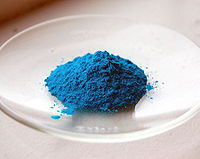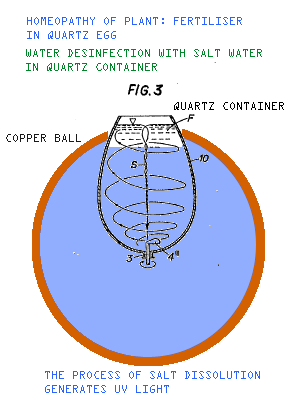One more thing: 
copper aspirinate -- properties & preparation if it is good for you .... it is good for a crystal battery as a potential candidate
 Blue
Blue 

copper aspirinate -- properties & preparation if it is good for you .... it is good for a crystal battery as a potential candidate

 Blue
Blue 
it appears that in addition to the anti-bacterial and anti-fungal activity of inorganic copper compounds as recognized by the ancients, metallo-organic complexes of copper have medicinal capabilities that are fundamental to the healing process itself.
Copper is known to be an essential element in human metabolism. However, copper does not exist in the body in measurable amounts in ionic form. All measurable amounts of copper in the body exist in tissues as complexes with the organic compounds of proteins and enzymes. Therefore, it has been concluded that copper becomes and remains intimately involved in body processes. Some copper complexes serve to store copper, others to transport it, and yet others play important roles in key cellular and metabolic processes. Studies into the roles that these copper complexes play and the mechanisms of these roles have further confirmed that copper enters into the prevention and control of a number of disease states in the body. As will be discussed below, the key to the effective use of copper-based pharmaceuticals is not the use of inorganic compounds of copper, as used by the ancients, but rather the use of metallo-organic complexes or chelates of copper. The process of chelating metals allows them to be smuggled in the transport process across the intestinal wall and thereby enter into the mainstream of nutrient flow and usage in the body.
The first modern research on the subject of copper medicinal substances was by Professor John R. J. Sorenson, of the University of Arkansas for Medical Sciences, College of Pharmacy, who, in 1966, demonstrated that copper complexes have therapeutic efficacy in the treatment of inflammatory diseases using doses that are nontoxic. Since then, copper metallo-organic complexes have been used to successfully treat patients with arthritic and other chronic degenerative diseases. More than 140 copper complexes of non-steroidal anti-inflammatory agents (aspirin and ibuprofen, for example) have been shown to be more active than their parent compounds. Copper aspirinate has been shown not only to be more effective in the treatment of rheumatoid arthritis than aspirin alone, but it has been shown to prevent or even cure the ulceration of the stomach often associated with aspirin therapy. Based on these experiences, the work of Professor Sorenson and other researchers around the world has progressed into the medicinal benefits of organic complexes of copper in a number of disease states. This work, thus far mainly based on animal research, has opened a whole new vista both into the understanding of copper's many-fold role in the body and in the practicality of using supplementary copper in the treatment of wound healing and inflammation-related disease states. Some of these potential indications are:
Copper is known to be an essential element in human metabolism. However, copper does not exist in the body in measurable amounts in ionic form. All measurable amounts of copper in the body exist in tissues as complexes with the organic compounds of proteins and enzymes. Therefore, it has been concluded that copper becomes and remains intimately involved in body processes. Some copper complexes serve to store copper, others to transport it, and yet others play important roles in key cellular and metabolic processes. Studies into the roles that these copper complexes play and the mechanisms of these roles have further confirmed that copper enters into the prevention and control of a number of disease states in the body. As will be discussed below, the key to the effective use of copper-based pharmaceuticals is not the use of inorganic compounds of copper, as used by the ancients, but rather the use of metallo-organic complexes or chelates of copper. The process of chelating metals allows them to be smuggled in the transport process across the intestinal wall and thereby enter into the mainstream of nutrient flow and usage in the body.
The first modern research on the subject of copper medicinal substances was by Professor John R. J. Sorenson, of the University of Arkansas for Medical Sciences, College of Pharmacy, who, in 1966, demonstrated that copper complexes have therapeutic efficacy in the treatment of inflammatory diseases using doses that are nontoxic. Since then, copper metallo-organic complexes have been used to successfully treat patients with arthritic and other chronic degenerative diseases. More than 140 copper complexes of non-steroidal anti-inflammatory agents (aspirin and ibuprofen, for example) have been shown to be more active than their parent compounds. Copper aspirinate has been shown not only to be more effective in the treatment of rheumatoid arthritis than aspirin alone, but it has been shown to prevent or even cure the ulceration of the stomach often associated with aspirin therapy. Based on these experiences, the work of Professor Sorenson and other researchers around the world has progressed into the medicinal benefits of organic complexes of copper in a number of disease states. This work, thus far mainly based on animal research, has opened a whole new vista both into the understanding of copper's many-fold role in the body and in the practicality of using supplementary copper in the treatment of wound healing and inflammation-related disease states. Some of these potential indications are:
Originally posted by MonsieurM
View Post




























Comment